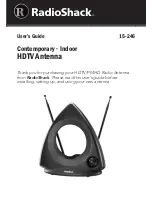
Stage 3. MOUNTING ANTENNA
Mounting the antenna includes considering three
factors; position, direction and polarisation.
Position:
Mount the antenna at highest point practicable,
the higher the better, whilst also maintaining close
proximity to antenna cabling.
Position the antenna at the closest point to the
broadcast transmitter; avoid any obstruction
between the antenna and the broadcast transmitter.
Antenna location should be away from sources of
RF noise such as motors.
Direction:
Point front of antenna directly towards broadcast
transmitter; if the transmitter is not visible,
position antenna in same direction as neighbouring
antennas; a compass or map can also help.
Using the Antsig signal strength meter (AP9000)
can greatly improve your success in achieving the
optimal direction for maximum signal strength.
Polarisation:
Transmitter broadcasting direction will determine
how the antenna should be mounted.
If the transmitter is broadcasting horizontally,
the antenna should have horizontal polarisation
(antenna should be mounted normal, see figure 3a).
If the transmitter is broadcasting vertically, antenna
should have vertical polarisation (antenna should be
mounted on its side).
For vertical polarisation of the antenna, a cross
member should be used (See figure.3b). A cross
member includes two masts that are perpendicular
to each other. Antenna should be mounted on its
side perpendicular to the mast as shown on
figure 3b.
Note: DAB+ is always vertically polarised.
4
Horizontal
Polarisation
To Transmitter
Fig.3a
Vertical
Polarisation
To Transmitter
Fig.3b


























